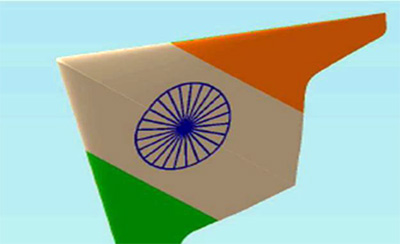INDIAN ARMED FORCES CHIEFS ON
OUR RELENTLESS AND FOCUSED PUBLISHING EFFORTS

SP Guide Publications puts forth a well compiled articulation of issues, pursuits and accomplishments of the Indian Army, over the years

I am confident that SP Guide Publications would continue to inform, inspire and influence.

My compliments to SP Guide Publications for informative and credible reportage on contemporary aerospace issues over the past six decades.
Aura to fly in 2018
 |
By Lt. General P.C. Katoch (Retd) Former Director General of Information Systems, Indian Army |

Our military’s requirement of UAVs has suffered past several years because of lack of industrial expertise, combined with delays and cost overruns. One major reason is that the private industry has not been allowed to grow in this field because of vested reasons - otherwise matching the massive drone industry of China could have taken off years back. This has also adversely affected border surveillance in face of concerted Pakistani attempts for infiltrating terrorists into India and Chinese intrusions along the Line of Actual control, recent intrusion in Tuting area of Arunachal being one example; chance detection of 1.25 km road constructed inside Indian Territory by a hunter. The Army does have an ambitious plan in next 3-5 years to equip UAVs down to the battalion level, while the Air Force plans to have fully operational squadrons of surveillance UAVs and unmanned combat aerial vehicles (UCAV). The plan includes the induction multiple man-portable mini and micro UAVs for short-range surveillance, and nuclear, biological, chemical detection in the battlefield. According to MoD sources, the private sector will be involved in a big in future to meet overall requirements of UAVs; in the next two years fresh tenders are to be floated for a variety of UAVs and that a concept study has commenced for developing a bomber UAV and a fighter UAV. But knowing the system and the continuing glitches in the Strategic Partnership Model (SPM), fielding of UAV’s down to ground levels appears sheer utopia; 6-10 years would perhaps be a better bet. However, according to more recent news, the indigenous ‘Ghatak’ unmanned combat air vehicle (UCAV), also called AURA, and under development by the DRDO is likely to take to the air this year. The Aeronautical Development Agency (ADA), responsible for the design work, describes Ghatak as a “self-defending high speed UAV with weapon firing capability”.
Ghatak will be the first indigenous stealth UCAV of India which the ADA is developing in conjunction IIT Kanpur. As per reports, Ghatak’s design is akin to Northrop Grumman’s B-2 Spirit, but this maybe more to do with looks, certain dynamics and stealth technology, because the latter is a ‘manned’ heavy penetration stealth bomber that features low, observable stealth technology designed for penetrating dense anti-aircraft environment. The program is presently in the project definition stage albeit the DRDO is confident that Ghatak’s scale model will be flown this year. The Ghatak UCAV will be capable of releasing missiles, bombs and precision-guided munitions (PGMs). The prototype codenamed SWiFT (stealth wing flying test-bed), SWiFT is to be fitted with a Russian NPO Saturn 36MT turbofan engine (which powers the Nirbhay cruise missile) and will be launched on its first flight during FY 2018-19 - most likely by end 2018. The Ghatak will be an air-launched UCAV for use by the IAF. In addition to performing tasks of airborne intelligence and gathering electronic intelligence, Ghatak would be capable of operating in hostile territory, evading enemy sensors by virtue of its stealth, and destroying identified targets with air-to-ground weapons. DRDO had earlier stated, major programs that had been finalized for the Army include induction of 500 mini and macro UAVs and an unspecified number of HALE UAVs; for the Air Force an unspecified number of UCAVs, 95 micro unmanned aerial systems and an unspecified number of small VTOL and mini unmanned aerial systems; for the Navy are 95 micro unmanned aerial systems and unspecified numbers of HALE UAVs costing around $200 million. DRDO’s Rustom-2 UAV had been successfully test flown year but despite the claim of provisioning the Army with UCAVs, DRDO eventually admitted that Rustom-2 will could not be converted into a UCAV - ‘combat’ drone; since DRDO was unable to integrate missiles with the Rustom series of drones.
Once the Ghatak is successfully tested, perhaps DRDO will be in a position to develop requisite UCAV for the Army as well. Pakistan tested its indigenous ‘Burraq’ UCAV in 2015 and same year China offered to sell Pakistan its CH-3 UCAV, which can carry two laser-guided missiles or bombs. In November 2016, China officially opened global export for the CH-5 combat drone, which had made its maiden flight in August 2015, including transfer of technology to buyers. The CH-5 is the largest and most lethal Chinese military drone in terms of operational endurance and payload capacity. The drone made of composite materials and has a wingspan of 21 meters. It can stay airborne for 60 hours and operate at an altitude of up to 10 km. Its current maximum range is 6,500 km, and next upgrade aims to enable flying range of 10,000 km. It can carry airborne early warning system, as well as electronic warfare instruments. With a payload of 1,000 kg of equipment and weapons, it can carry 16 air-to-surface missiles. During 2017, the CH-5 was photographed at an airbase in Pakistan. China plans to develop advanced version of CH-5 capable of staying in the air for up to 120 hours, with a 20,000 km range. India definitely has much catching up to do.





